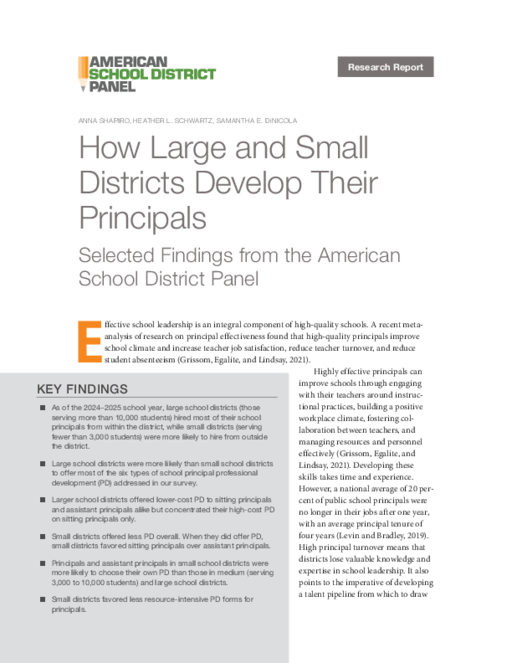Research Approach
Survey:
The spring 2025 ASDP survey was administered to a national sample of K–12 public school districts between March 11, 2025, and May 2, 2025. Of the 7,888 public school districts that were invited to take the survey, 207 districts completed the survey items used in this report. The survey was designed to allow multiple respondents from the same district central office to complete portions of the survey. The researchers recommended that the person in the district central office who oversees HR and/or principal supervision complete the survey; however, they do not know which person(s) in each district completed the survey on behalf of their districts.
Estimates were produced using cross-sectional survey weights designed using data on district demographics and poverty levels. When applied, these survey weights make the districts in this sample look similar to the national population of K–12 public school districts, at least on such observable characteristics as district locale, enrollment size, poverty level, geographic region, and student racial or ethnic composition. Importantly, survey responses were weighted to be representative of the national population of public school districts, not the national population of public school students. For more information about the weighting procedures for ASDP surveys, see Grant et al. (2025).
Analysis:
The authors analyzed differences in districts’ responses to survey items by the following characteristics:
enrollment size (they categorize small districts as those with fewer than 3,000 students and large districts as those with more than 10,000 students; they categorize the remaining districts as medium)
locale (urban, suburban, and rural)
student racial or ethnic composition (they categorize districts in which more than one-half of students are Black, Hispanic, Asian, Pacific Islander, American Indian or Alaska Native, or of two or more races as having majority students of color, with the remaining districts categorized as having majority White students)
poverty status (low-poverty districts are those in the first quartile—that is, those with the fewest families with income below the federal poverty rate; middle-poverty districts are those in the second and third quartiles; high-poverty districts are those in the fourth quartile—that is, those with the highest shares of families with incomes below the federal poverty rate).
The researchers conducted significance testing to assess whether district subgroups were statistically different at the p < 0.05 level. In the report, unless otherwise noted, they describe only those differences among district subgroups that are statistically significant at the 5 percent level. Furthermore, because of the exploratory nature of this study, they did not apply multiple hypothesis test corrections.
Researchers can download survey data files to perform their own analyses by visiting the American Educator Panels Data Portal available on www.rand.org/aep.

